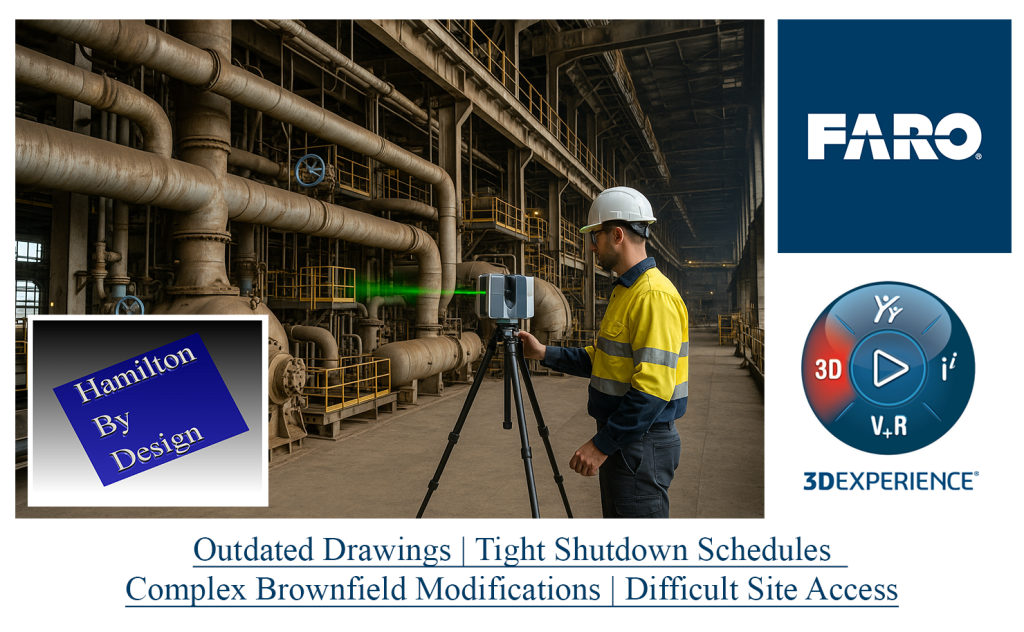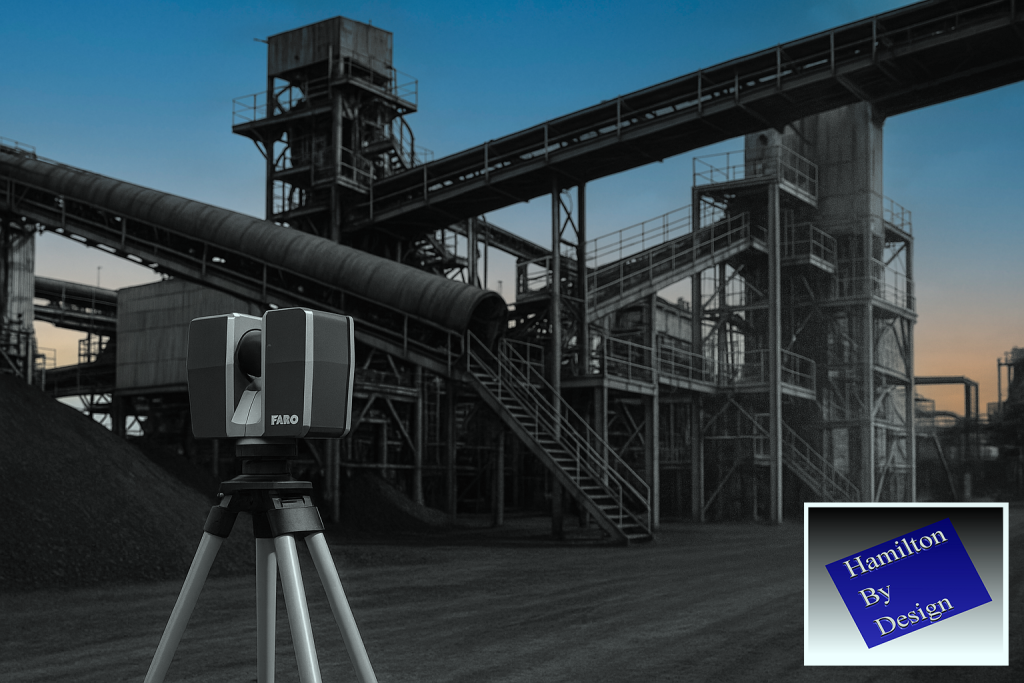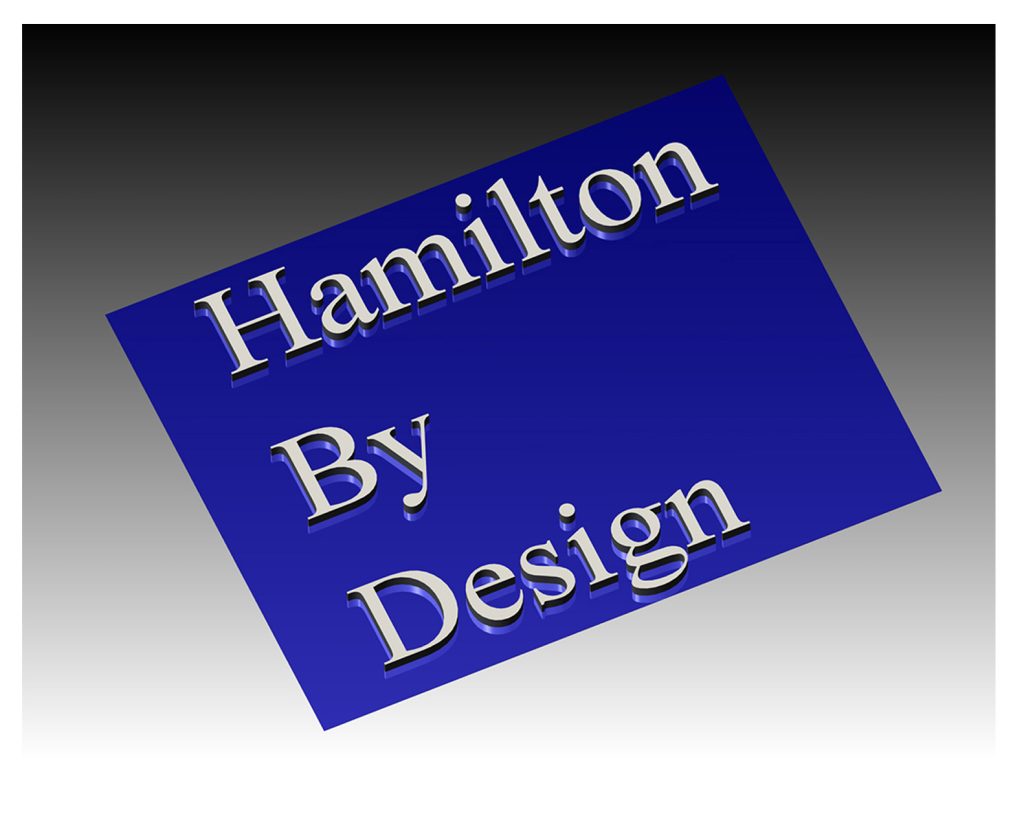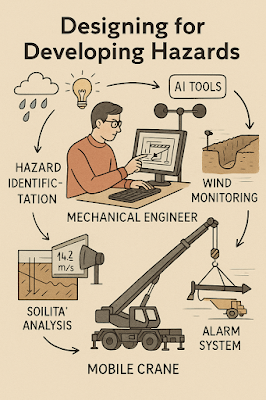Engineering the Hunter: Precision Meets Industry
Few regions in Australia represent heavy industry quite like Newcastle and the Hunter Valley.
From the coal mines at Bengalla and Mount Thorley, to the power stations at Bayswater and Eraring, to the Port of Newcastle’s massive shiploaders and conveyors, this region has powered Australia for generations.
But with age, complexity, and constant upgrades come challenges:
- Outdated drawings
- Tight shutdown schedules
- Complex brownfield modifications
- Difficult site access
That’s where 3D scanning and LiDAR modelling are transforming how industrial projects are designed, verified, and delivered — ensuring every bolt, beam, and bracket fits perfectly the first time.
At Hamilton By Design, we bring together field experience, digital precision, and local knowledge to help the Hunter’s industries design, maintain, and modernise with confidence.

What Is 3D Scanning — and Why It Matters in Industry
3D laser scanning, also known as LiDAR (Light Detection and Ranging), captures millions of data points across an industrial site to create a precise digital representation — known as a point cloud.
This point cloud forms the foundation of a digital twin of your plant or asset — an exact, measurable 3D environment that engineers can design within using SolidWorks, AutoCAD, or Navisworks.
The result?
Every measurement is accurate, every clash is detected before fabrication, and every installation happens exactly as planned.
Why Newcastle and the Hunter Valley Need Scanning More Than Ever
The Hunter is an engineering powerhouse — but much of its infrastructure was built decades ago.
Many coal handling plants, power stations, and smelters are now in a constant cycle of refurbishment, retrofit, and compliance upgrade.
The challenges are familiar:
- Old 2D drawings don’t reflect today’s reality.
- Assets have been modified repeatedly over decades.
- Shutdown windows are shrinking.
- Every error adds cost and delays production.
By scanning before you design, you remove uncertainty.
You don’t guess clearances — you know them.
You don’t estimate tie-in points — you model them.
You don’t hope it fits — you prove it digitally.
That’s the power of 3D scanning in today’s industrial environment.

Where Scanning Adds Value Across the Hunter’s Industries
⚙️ Power Generation
The Bayswater, Eraring, and Vales Point Power Stations are engineering icons.
Upgrades to cooling systems, ducts, platforms, and access structures require millimetre accuracy.
3D scanning ensures:
- Every retrofit aligns with existing steelwork and pipework.
- Structural interferences are caught before fabrication.
- Shutdown work can be completed on time — without rework.
Whether it’s a fan casing replacement or a duct reroute, laser scanning removes the guesswork from aging assets.
⛏️ Coal Handling and CHPP Facilities
The Hunter Valley’s CHPP network — Mount Thorley Warkworth, Ravensworth, Bengalla, Hunter Valley Operations — all depend on reliable mechanical systems.
These plants evolve continuously: diverter chutes, screen replacements, conveyors, and wash plant modifications.
Scanning delivers:
- Accurate as-built geometry for plant upgrades.
- Clash detection between new and existing equipment.
- Shutdown planning certainty — no unexpected fit-up issues.
- Integration of SolidWorks models directly into point clouds for visual verification.
For CHPP managers and maintenance engineers, 3D scanning is now as essential as the plant itself.

⚓ Port of Newcastle and Coal Export Terminals
Newcastle’s port is the lifeline of the Hunter’s economy.
Facilities such as Port Waratah Coal Services (PWCS), Newcastle Coal Infrastructure Group (NCIG), and Carrington Terminal handle massive volumes of coal every hour.
The complexity of these sites — shiploaders, conveyors, gantries, and stacker-reclaimers — demands accuracy during maintenance and upgrade works.
3D scanning supports:
- Shiploader upgrades and boom extensions.
- Conveyor and transfer tower alignment checks.
- Wharf structure condition monitoring.
- Integration with mechanical and electrical systems.
By scanning before modification, downtime is reduced, safety improves, and project teams gain total confidence in every fit-up.
🏭 Aluminium and Heavy Manufacturing
At Tomago Aluminium Smelter, precision is everything.
The scale of the site — from potlines to switchyards — makes manual measurement impractical and unsafe.
Laser scanning captures geometry accurately across large areas, enabling:
- Retrofit planning without full shutdowns.
- Clearance checks for cranes, ducts, and potline infrastructure.
- Digital twins for long-term maintenance and asset management.
Beyond Tomago, manufacturers in Waratah, Beresfield, and Thornton use scanning to validate jigs, fixtures, and workshop layouts — ensuring local fabrication accuracy that matches site requirements.
🔋 Emerging Energy and Infrastructure
As the Hunter region transitions toward renewable and low-emission industries, scanning plays a critical role in planning new infrastructure around existing sites.
This includes:
- Hydrogen and gas pipeline tie-ins.
- Solar and battery installations near existing grid connections.
- Conversion of existing power plant structures for new technology.
Accurate point-cloud data ensures new energy meets old infrastructure safely and efficiently.
From Field to Fabrication: The Hamilton By Design Process
At Hamilton By Design, our 3D scanning workflow is built around practical, industrial needs:
- Site Scan & Data Capture
Using high-precision LiDAR scanners, we safely capture full site geometry in hours, not weeks.
Scans are performed during operation or short shutdowns, without interrupting production. - Point Cloud Registration & Processing
Multiple scans are aligned to create a unified, accurate model of your facility.
The result is a true “digital twin” of your asset, complete with millimetre accuracy. - SolidWorks Modelling & Integration
Our design team converts scan data into fully functional 3D models — chutes, pipework, platforms, or structural frames — ready for fabrication. - Clash Detection & Design Validation
Every new design is tested within the digital twin, ensuring it fits the first time. - Fabrication Drawings & e-Drawings
Detailed 2D and 3D deliverables are provided for fabricators, site crews, and certifiers — ensuring seamless communication between design and construction.
Why Local Expertise Matters
Many engineering firms offer scanning — but few understand what it takes to work on a live plant in the Hunter Valley.
Hamilton By Design combines trade experience, mechanical design, and regional understanding.
We’ve worked with the same assets, fabricators, and contractors who keep the region’s power, port, and manufacturing industries running.
We design for real fabrication conditions — using Australian Standards, local materials, and practical build methods.
That means fewer redesigns, faster turnarounds, and safer installations.
Safety and Access: Scanning Without Shutdowns
Traditional site measurement often means working at heights, in confined spaces, or around operating equipment.
3D scanning eliminates those risks.
Our scanners capture data safely from the ground — even in restricted or hazardous areas.
This not only improves safety but also allows projects to continue without halting production.
For large plants like Eraring or PWCS, scanning entire structures during live operation is now standard practice — enabling ongoing maintenance and long-term asset integrity planning.
Case Example: Port Upgrade Without Rework
A local contractor approached Hamilton By Design for a conveyor and tower modification project at the Port of Newcastle.
Existing drawings were decades old, and the structure had been modified repeatedly.
We performed a 3D scan of the tower and adjacent conveyors, capturing the as-built geometry in one day.
The resulting model revealed several misalignments between the planned chute and existing supports.
By correcting these in SolidWorks before fabrication, the contractor avoided at least 48 hours of site rework and kept the shutdown on schedule.
That’s measurable ROI — precision that pays for itself.
The ROI of 3D Scanning in Heavy Industry
A single hour of lost production at a CHPP or power station can cost $20,000 to $50,000.
A single day’s delay can exceed $500,000 in lost revenue and labour costs.
3D scanning reduces that risk by eliminating rework and ensuring every component fits right the first time.
Typical return on investment (ROI):
- Scanning cost: <1% of total project value.
- Rework savings: 3–10% of total cost.
- Downtime reduction: 1–3 days saved per shutdown.
When accuracy drives reliability, 3D scanning isn’t an expense — it’s insurance.
Supporting the Hunter’s Future
Newcastle and the Hunter Valley are evolving — from coal and power to renewables, advanced manufacturing, and logistics.
But one thing hasn’t changed: the region’s foundation in engineering, precision, and hard work.
Hamilton By Design supports that legacy with the next generation of technology — scanning, digital modelling, and mechanical design that keep the region’s assets efficient, safe, and ready for the future.
We’re not an offshore CAD vendor.
We’re local engineers who’ve worked in the field, understand your equipment, and speak the same language as your crews.
Let’s Build the Future of Hunter Industry – Accurately
Every project starts with one question: “Do we have accurate site data?”
With Hamilton By Design, the answer is always yes.
We deliver:
✅ 3D laser scanning and LiDAR modelling
✅ Point-cloud to SolidWorks integration
✅ Reverse engineering and FEA validation
✅ Fabrication drawings tailored for local workshops
✅ On-site consultation with practical engineering insight
Whether you’re upgrading a conveyor at Bayswater, fabricating platforms for Tomago, or retrofitting process piping at Kooragang, we ensure your next project fits perfectly — before steel is cut.

👉 Get your industrial site scanned and modelled before your next shutdown.
Visit www.hamiltonbydesign.com.au or contact us to request a capability statement today.
Mechanical Engineering | Structural Engineering
Mechanical Drafting | Structural Drafting
3D CAD Modelling | 3D Scanning





